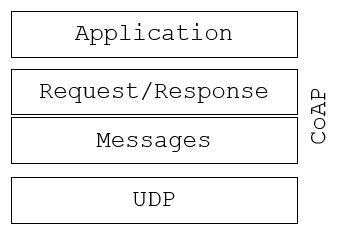Difference between revisions of "Constrained Application Protocol"
| Line 20: | Line 20: | ||
== The Protocol == | == The Protocol == | ||
CoAP is similar to the client/server model of HTTP. M2M interactions typically result in a CoAP implementation acting in both client and server roles. A request is sent by a client to request an action on a resource (identified by a URI) on a server. The server then sends a response with a response code (equivalent to that of HTTP). Therefore, efficiency is very important, so CoAP uses UDP, a datagram-oriented transport. | |||
[[File:Abstract_Layering_of_CoAP. | CoAP is however a single protocol, with messaging and request/response as just features of the CoAP header | ||
+----------------------+ | |||
| Application | | |||
+----------------------+ | |||
+----------------------+ \ | |||
| Requests/Responses | | | |||
|----------------------| | CoAP | |||
| Messages | | | |||
+----------------------+ / | |||
+----------------------+ | |||
| UDP | | |||
+----------------------+ | |||
[[File:Abstract_Layering_of_CoAP.JPG]] | |||
== Message Format == | |||
By default, the messages are encoded in a simple binary format and transported over UDP. The messages are encoded in a simple binary format | |||
0 1 2 3 | |||
0 1 2 3 4 5 6 7 8 9 0 1 2 3 4 5 6 7 8 9 0 1 2 3 4 5 6 7 8 9 0 1 | |||
+-+-+-+-+-+-+-+-+-+-+-+-+-+-+-+-+-+-+-+-+-+-+-+-+-+-+-+-+-+-+-+-+ | |||
|Ver| T | TKL | Code | Message ID | | |||
+-+-+-+-+-+-+-+-+-+-+-+-+-+-+-+-+-+-+-+-+-+-+-+-+-+-+-+-+-+-+-+-+ | |||
| Token (if any, TKL bytes) ... | |||
+-+-+-+-+-+-+-+-+-+-+-+-+-+-+-+-+-+-+-+-+-+-+-+-+-+-+-+-+-+-+-+-+ | |||
| Options (if any) ... | |||
+-+-+-+-+-+-+-+-+-+-+-+-+-+-+-+-+-+-+-+-+-+-+-+-+-+-+-+-+-+-+-+-+ | |||
|1 1 1 1 1 1 1 1| Payload (if any) ... | |||
+-+-+-+-+-+-+-+-+-+-+-+-+-+-+-+-+-+-+-+-+-+-+-+-+-+-+-+-+-+-+-+-+ | |||
== Courses == | == Courses == | ||
Revision as of 13:38, 11 March 2019
The Constrained Application Protocol (CoAP) is a specialized web transfer protocol, as defined in RFC 7252, for use with constrained nodes and constrained networks in the Internet of Things. The protocol is designed for machine-to-machine (M2M) applications such as smart energy and building automation.
Features
The work on Constrained Environments aims at realizing the REST architecture in a suitable form for the most constrained nodes and networks. The nodes usually consist of 8-bit microcontrollers with limited amounts of RAM and ROM.
CoAP has the following main features:
- Web protocol fulfilling M2M requirements in constrained environments
- UDP [RFC0768] binding with optional reliability supporting unicast and multicast requests
- Asynchronous message exchanges
- Low header overhead and parsing complexity
- URI and Content-type support
- Simple proxy and caching capabilities
- Stateless HTTP mapping
- Security binding to Datagram Transport Layer Security (DTLS)
The Protocol
CoAP is similar to the client/server model of HTTP. M2M interactions typically result in a CoAP implementation acting in both client and server roles. A request is sent by a client to request an action on a resource (identified by a URI) on a server. The server then sends a response with a response code (equivalent to that of HTTP). Therefore, efficiency is very important, so CoAP uses UDP, a datagram-oriented transport.
CoAP is however a single protocol, with messaging and request/response as just features of the CoAP header
+----------------------+
| Application |
+----------------------+
+----------------------+ \
| Requests/Responses | |
|----------------------| | CoAP
| Messages | |
+----------------------+ /
+----------------------+
| UDP |
+----------------------+
Message Format
By default, the messages are encoded in a simple binary format and transported over UDP. The messages are encoded in a simple binary format
0 1 2 3 0 1 2 3 4 5 6 7 8 9 0 1 2 3 4 5 6 7 8 9 0 1 2 3 4 5 6 7 8 9 0 1 +-+-+-+-+-+-+-+-+-+-+-+-+-+-+-+-+-+-+-+-+-+-+-+-+-+-+-+-+-+-+-+-+ |Ver| T | TKL | Code | Message ID | +-+-+-+-+-+-+-+-+-+-+-+-+-+-+-+-+-+-+-+-+-+-+-+-+-+-+-+-+-+-+-+-+ | Token (if any, TKL bytes) ... +-+-+-+-+-+-+-+-+-+-+-+-+-+-+-+-+-+-+-+-+-+-+-+-+-+-+-+-+-+-+-+-+ | Options (if any) ... +-+-+-+-+-+-+-+-+-+-+-+-+-+-+-+-+-+-+-+-+-+-+-+-+-+-+-+-+-+-+-+-+ |1 1 1 1 1 1 1 1| Payload (if any) ... +-+-+-+-+-+-+-+-+-+-+-+-+-+-+-+-+-+-+-+-+-+-+-+-+-+-+-+-+-+-+-+-+
Courses
References
- RFC 7252: https://tools.ietf.org/html/rfc7252
- CoAP: RFC 7252 Constrained Application Protocol https://coap.technology/
- Learning Internet of Things: https://www.oreilly.com/library/view/learning-internet-of/9781783553532/
